| Scania K230UB | |
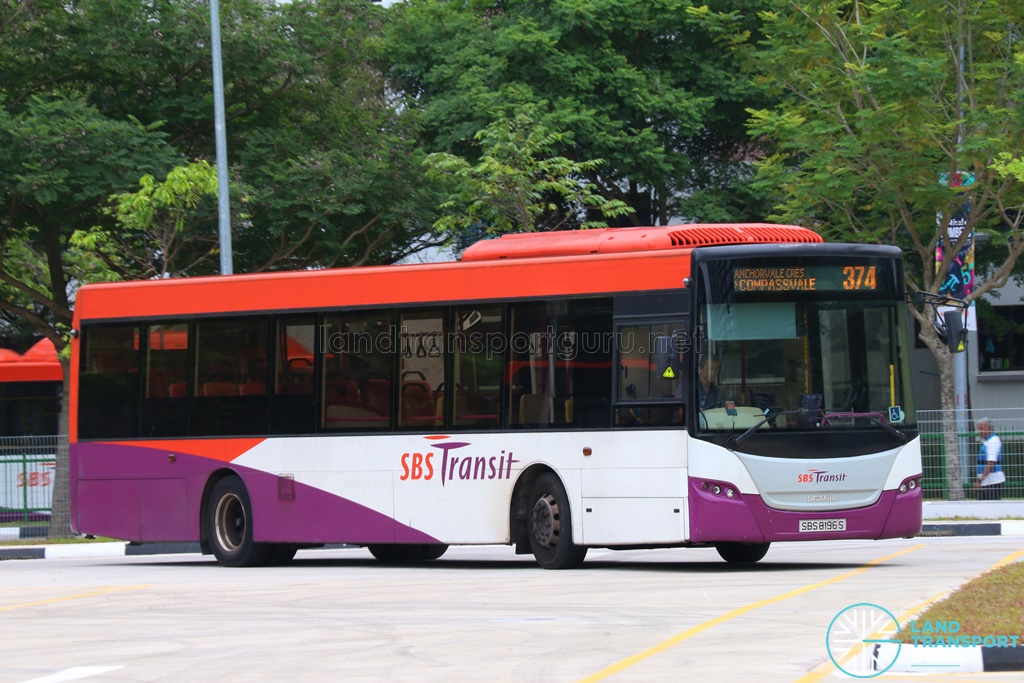 |
|
| Manufacturer | Scania AB |
| Bodywork | Gemilang Coachworks |
| Years in operation | 2007 – Present |
| Operators | SBS Transit SMRT Buses (Former) |
| Technical Data | |
| Length | 12 metre |
| Engine | Scania DC9 16 230 (Euro IV) Scania DC9 35 230 (Euro V) |
| Transmission | ZF Ecomat 6HP 502C (Euro IV) ZF Ecomat 6HP 504C (Euro V) |
| Accessibility | Low Entry & Wheelchair-accessible |
| Emission Standard | Euro IV / V (EGR) |
The Scania K230UB (K-Series 230-bhp Urban Bus) is a low-entry, single-deck city bus chassis offered by Scania AB. Also referred to as the ‘Scania KUB’ or simply ‘KUB’, it is one of many configurations offered by Scania’s K-series of bus chassis for city and intercity buses.
SBS Transit is the largest local operator of Scania K230UB buses in Singapore, with 1,101 vehicles introduced between 2007 and 2010. It was then the largest volume order for any single bus model for the public transport fleet, until it was superseded by the Volvo B9TL. Vehicles are configured as low-entry buses, with bodywork supplied by Gemilang Coachworks of Malaysia.
The low-entry design offers zero-step access between the entry and exit doors, allowing for more convenient boarding/alighting and disabled access. This is achieved by relocating drivetrain components to the rear of the bus.
Smaller numbers of Scania K230UB buses are also owned by private operators.
In March 2024, several Scania K230UB buses were transferred to SMRT Buses in preparation for its operation of the Jurong West Bus Package from September 2024. All buses were transferred back to SBS Transit by end-July 2025.
Type Information:
All Scania K230UB units operating in Singapore are of the K230UB 4×2 make. The model number is broken down as follows:
- K: K-series chassis (centrally-mounted longitudinal engine behind rearmost axle)
- 230: Power output in horsepower (230hp) rounded to nearest 10
- U: Urban Bus (City bus)
- B: No special adaptation (Rigid Bus)
- 4×2: Wheel configuration (two-axle vehicle, driven rear axle)
Since 2006, Scania’s bus and coach chassis options are characterised as K, N or F-series based on engine layout. The N-series have transversely-mounted engines and transmission units, allowing for a full-low-floor layout. The F-series are for front-engined buses.
There are two variants of Scania K230UB city buses in Singapore, the Euro IV and the Euro V. Both fulfil the requirements of the Euro IV and Euro V emissions standards using Exhaust Gas Recirculation (EGR) technology. Unlike other Euro IV and V bus models using SCR, the Scania K230UB buses do not require diesel exhaust fluids.
Technical Information:
Chassis layout:

The bus is constructed on Scania’s K series of bus chassis, which are characterized by the same drivetrain layout: having a centrally-mounted engine and transmission unit oriented longitudinally behind the drive axle (rear axle). Along with a lowered rigid front axle, this allows the Scania KUB to be bodied as a low-entry bus.
The K series chassis can also be configured as an articulated bus, or as a 3-axle coach/double-deck bus like the Scania K310UD double-deck bus in Singapore. This is done with the addition of a tag axle behind the drive axle, with optional rear axle steering (RAS) capability.
Powertrain:
Both Euro IV and V Scania K230UB buses in Singapore are fitted with the DC9 engine rated at 230 horsepower (169 kW).
Scania K series diesel engine offerings (Click to expand)The K series was launched in 2006 with the Euro IV-compliant Scania DC9 and Scania DC12 engines. In 2008, these would be replaced by the newly-offered Euro V-compliant Scania DC9 (later renamed Scania DC09) and Scania DC13 engines, and Euro VI-compliant engines would follow suit. All engines are offered over a range of power outputs.
| Scania K series diesel engine offerings | ||||
| Euro IV (2006) | Euro V (Launched 2008) | Euro VI (Launched 2013) | ||
| Scania DC9 (5-cylinder, 8.9-litre) |
230 hp (1050 Nm) 270 hp (1250 Nm) 310 hp (1550 Nm) |
Scania DC9 / Scania DC09 (5-cylinder, 9.3-litre) |
230 hp (1050 Nm) 270 hp (1250 Nm) 320 hp (1600 Nm) |
250 hp (1250 Nm) 280 hp (1400 Nm) 320 hp (1600 Nm) 360 hp (1700 Nm) |
| Scania DC12 (6-cylinder, 11.7-litre) |
340 hp (1700 Nm) 380 hp (1900 Nm) 420 hp (2100 Nm) 470 hp (2200 Nm) |
Scania DC13 (6-cylinder, 12.7-litre) |
380 hp (1900 Nm) 420 hp (2100 Nm) 480 hp (2250 Nm) |
410 hp (2150 Nm) 450 hp (2350 Nm) 490 hp (2550 Nm) |
For the export market, Euro III engines are also offered. All these engine options are also offered with Scania’s truck range.
In addition to this wide range of diesel engines, a separate range of engines are also offered for alternative fuels, such as Biogas/Natural Gas, Biodiesel, and Hydrotreated Vegetable Oil (HVO).
Bodywork:
Gemilang Coachworks of Malaysia supplied the bodywork for all SBS Transit Scania K230UB buses in the form of complete knock-down (CKD) kits. Only three buses were assembled by Gemilang; the remainder were assembled locally in Singapore by ComfortDelGro Engineering and SC Auto.
The bodywork utilises EcoRange, a lightweight aluminium bus body structure developed by Alcan (now known as Constellium).
Private operators of the Scania K230UB in Singapore have also opted for Gemilang Coachworks bodywork (similar to SBS Transit) or the SC Chivalrous bodywork (coach bodywork from SC Auto).
— Demonstrator | Euro IV Batch 1 | Euro IV Batch 2 | Euro V Batch 1 | Euro V Batch 2 —
SBS Transit Scania K230UB overview:
In 2006, SBS Transit launched its first wheelchair-accessible bus, the double-deck Volvo B9TL bodied by Comfort DelGro Engineering. With the upcoming retirement of the Volvo B10M MkII, Scania N113CRB and Mercedes-Benz O405 buses, there was a need to bring in more wheelchair-accessible single-deck buses to replace these older models, and at the same time, meet with more stringent vehicular emission requirements set by government agencies.
1,101 units of the Scania K230UB were delivered between 2007 and 2010, the largest intake of any bus model in Singapore at the time. All KUBs are of the low-entry configuration, with a manual wheelchair ramp at the rear doors.
The first 501 were of the Euro IV specification, while the remaining 600 were of the Euro V specification. All were fitted with ZF 6HP transmission units and bodied by Gemilang Coachworks of Malaysia. A detailed specification list is as follows:
| SBS Transit Scania K230UB | ||||
| Euro IV Batch 1 | Euro IV Batch 2 | Euro V Batch 1 | Euro V Batch 2 | |
| Registration | SBS8033D*, SBS8034B – SBS8131D, SBS8138K & SBS8888D |
SBS8132B – SBS8561X except SBS8138K & several skipped numbers |
SBS8562T – SBS8999S except SBS8888D & several skipped numbers |
SBS5001R – SBS5252H & several skipped numbers |
| Quantity | 101 | 400 | 400 | 200 |
| Registration Period | 19 Oct 2007 – 27 Dec 2007 |
4 Apr 2008 – 15 Jan 2009 |
13 Mar 2009 – 22 Dec 2009 |
27 Jan 2010 – 15 Jun 2010 |
| Technical Specifications | ||||
| Engine | Scania DC9 16 230 (Euro IV / EGR) In-line 5-cylinder (fixed-geometry) turbocharged |
Scania DC9 35 230 (Euro V / EGR) In-line 5-cylinder (variable-geometry) turbocharged |
||
| Emission Standard | Euro IV compliant Exhaust Gas Re-circulation (EGR) technology, without the need for diesel exhaust fluids. |
Euro V compliant Exhaust Gas Re-circulation (EGR) technology, without the need for diesel exhaust fluids. |
||
| Displacement | 8867cc | 9290cc | ||
| Power/torque | 230 hp (169 kW) @ 1800 rpm / 1050 Nm @ 1100 – 1500 rpm |
230 hp (169 kW) @ 1900 rpm / 1050 Nm @ 1000 – 1500 rpm |
||
| Transmission | ZF Ecomat 6HP 502C | ZF Ecomat 6HP 504C | ||
| Bodywork | Gemilang Coachworks Produced as complete knocked-down (CKD) kits. All but 3 units assembled in Singapore by ComfortDelGro or SC Auto. Uses Alcan’s EcoRange aluminium bus body. |
|||
| Bodywork Assembly | ComfortDelGro Engineering (99) Gemilang Coachwork (2) – SBS8033D & SBS8888D |
ComfortDelGro Engineering (300) SC Auto (100) |
ComfortDelGro Engineering (280) SC Auto (119) Gemilang Coachwork (1) |
ComfortDelGro Engineering (200) |
| Passenger Capacity** | L29 + S58 2 wheelchair bays |
L30 + S58 2 wheelchair bays |
L34 + S53 1 wheelchair bay |
L34 + S53 1 wheelchair bay |
| EDS | Shanghai CanRun Electron Tech KLHP-7B1-2 (Branded as Cool-Air) Orange LED matrix design |
Hanover Orange LED matrix design |
||
| Seats | Vogelsitze System 400 (8033D) Vogelsitze System 750/3 (The rest) |
Vogelsitze System 750/3 Vogelsitze System 601 (Wheel arch seat) |
Vogelsitze System 750/3 | Vogelsitze System 750/3 |
| Air conditioning | Denso LD8u | Eberspächer Sütrak AC 353 G4 III+ | ||
| Additional Specifications | No wheel arch seats Two wheelchair bays Cruise control (some units) |
One wheel arch seat Two wheelchair bays |
Two wheel arch seats One wheelchair bays |
|
* – SBS8033D is a demonstrator unit
** – Passenger capacity: L = Lower Deck, S = Standing
Brief trials of low-entry buses like the Volvo B7RLE [SBS8030L] and MAN 18.240 HOCL-NL (A69) [SBS8031J] were conducted after the debut of the Scania K230UB, but none of these trials translated to volume orders.
Electronic Display Signs (EDS) were fitted to all Scania K230UB buses, supplied by Shanghai CanRun Electron Tech (branded as Cool-Air) (for all Euro IV units) and later by Hanover (for all Euro V units)—this makes Euro IV and V units easily distinguishable from the exterior.
The use of EDS on all buses was a significant departure for SBS Transit away from plastic route destination plates which they have used in the past, long after SMRT Buses (and predecessor TIBS) adopted EDS on its buses. Previously, excluding one-off demonstrator buses, the Dennis Trident was the only volume order of SBS Transit bus that was fitted with EDS when newly delivered. EDS units would be standard for all future bus purchases after the Scania K230UB.
On the interior, all Euro V buses have a front-facing seat just behind the entrance door, a feature not found on Euro IV buses. Euro IV buses have two wheelchair bays; Euro V buses have just one.
Fleetwide modifications:
Scania K230UB buses received the following fleetwide modifications midway through their lifespan:
- Electronic horn — replaced original air horn (exact date range unconfirmed)
- Updated instrument cluster — gradually replaced old instrument cluster (exact date range unconfirmed). Original instrument cluster has diagnostics screen on the right of the dashboard; updated one has the diagnostics screen in the centre of the dashboard
- Denso LD8u air-conditioning units (Euro IV units only) — replaced original Denso LD8i units from 2014 to 2016
- Eberspächer Sütrak AC 353 G4 III+ air-conditioning units (Euro V units only) — replaced original Carrier Sütrak AC 353 units from late 2016 to 2018
- Trapeze Common Fleet Management System — installed fleetwide from 2016 to 2017, replaced original SBS Transit DDU
- Exterior-mounted exit door sensors (model: Pepperl+Fuchs UC2000-L2 ultrasonic sensor) — first trialed in 2015, then installed fleetwide from 2019 to 2020. Replaced original interior door sensors.
- Mobileye Collision Avoidance System — first trialed in 2014, then installed fleetwide from 2016 to 2019. Mix of Mobileye 560 and Mobileye 630 models.
- TNT Surveillance SAGE R-BASIC telematics system — installed fleetwide from 2018 to 2020
- Free Wi-Fi — Only installed on Bukit Merah Bus Package buses. Supported by Starhub.
- Stroller Restraint System — installed fleetwide from 2019 to 2020
Special Features:
Some buses received additional fittings for advertising or trial purposes:
- Moove Bling LED Side Lighting — Introduced starting in 2016 on several buses. Part of the Moove Bling advertising feature by Moove Media (advertising arm of ComfortDelGro). Features 15 LED lamps installed above the windowline.
- Moove Media Wi-Fi Bus — Free Wi-Fi offered as part of advertising campaigns; often paired with full-body bus advertising
- Starhub Wi-Fi trial — Collaboration with Veniam; one year trial from Jul 2017 – Jul 2018 offering free Wi-Fi on Bus Service 291. Installed onboard 8 buses.
- GWS Living Art Green Roof — Three month investigation into whether green roofs can effectively reduce heat transmissions in public buses. Green roofs were installed on 10 Scania K230UB buses.
- INIT Assistive Passenger Information System — Six month trial in 2019, expanded in 2020. Buses were retrofitted with a Driver Display Unit, Internal and External Speakers, and an Induction loop aerial (for hearing aid users).
Special Registration Numbers:
- During the 2010 Youth Olympic Games (YOG), 38 Scania K230UB buses (Euro V Batch 2, then the newest buses in the fleet) were chartered out to ferry athletes within the YOG Village in NTU. These buses bore a special full-bodied YOG livery and the YOG-prefixed registration plates YOG2141 – YOG2177.
- During the 8th ASEAN Para Games in 2015, 40 Scania K230UB buses (Euro IV) were chartered to shuttle athletes and event staff between venues. All buses bore a special ASEAN Para Games 2015 livery, and 29 of these buses bore special APG-prefixed registration plates.
Special modifications:
COMET MAXI
Main Article: Public Buses converted into COVID-19 Bus Transporters (COMET MAXI)
In June 2020, during the COVID-19 outbreak, 5 Scania K230UB buses (SBS8702G, SBS8856X, SBS8927A, SBS8939R, SBS8941H) were retrofitted into COMET MAXIs.
These specially modified vehicles were used to facilitate the mass transfer of COVID-19 patients between facilities, such as hospitals, dormitories and various community facilities.
These buses would progressively return to revenue service from Aug 2021, after uninstalling the modifications.
Refurbishment:
In 2021 & 2022, refurbishment of Scania K230UB Euro IV & Euro V buses commenced respectively. Refurbished buses feature a fresh coat of paint on the interior and exterior, new floor covers as well as interior & exterior stickers conforming to the latest Land Transport Authority standards.
Additional Refurbishment
In July 2025, SBS Transit issued a tender for “Supply of Labour and Parts for Refurbishment of 290 Scania Euro 4 Buses” (Reference No. TQ25A2014). The additional refurbishment would be for extended lifespan buses.
SBS Transit Euro IV Demonstrator Unit (SBS8033D):
In 2007, SBS Transit took delivery of a Scania K230UB demonstrator bus. The bus was registered on 19 October 2007 as SBS8033D, with several Euro IV Batch 1 KUBs registered on the same day.
Unlike other demonstrator buses which typically precede production batch buses by several months or years, SBS Transit’s Scania K230UB demonstrator was registered concurrently with production batch buses, although it was built much earlier.
Since the bulk order for 100 Gemilang-bodied Scania K230UB buses had been made the previous year (in 2006), SBS8033D’s role as a demonstrator bus is more of a bodywork prototype for SBS Transit evaluation, as opposed to the ‘typical’ demonstrator bus, where a new bus model is evaluated on revenue service over several months or years prior to bulk purchase.
It is not known how much SBS Transit paid for the purchase of SBS8033D, as this bus is not included as part of any subsequent volume orders.
Features:
SBS8033D was bodied by Gemilang Coachworks, a Malaysian coachbuilder that would supply the bodywork for all 1,101 production batch buses in the form of completely-knocked-down (CKD) kits.
The bus originally bore a unique front design with a recessed region above the license plate and larger headlights versus the production batch.
SBS8033D is fitted with the Scania DC9 16 230 turbocharged engine and the ZF Ecomat 6HP 502C six-speed automatic transmission, which would be standard across buses of the Euro IV batch. On the interior, SBS8033D is distinctively different from production batch units, featuring a beige and purple colour scheme (Production Batch buses opted for a light brown interior), an older model of bus seats, among other features. Layout of the interior, on the other hand, is largely similar.
SBS8033D entered revenue service some time in November 2007 (exact date unconfirmed). Production batch units made their debut on 1 November 2007.
Comparison Table:
Many features on SBS8033D would be modified before incorporation into the production batch buses. This list is not exhaustive:
| Demonstrator (SBS8033D) | Production Batch | |
| Front design | One-off front bumper design; possibly inspired by the Scania OmniCity or OmniLink integral bus; deep recessed region above number plate for Scania badge, large reflector headlamps, rectangular indicators. Replaced with Production Batch front in August 2013 after an accident | SBS8033D-derived front bumper design; shallower recessed region for Scania badge, smaller-sized round headlamps and round indicators |
| Rear design | Protruding ‘shield’ for reversing camera above rear window, incandescent bulbs for brake/signal indicator lamps (later replaced with LED) | No rear reversing camera housing, LED bulbs for brake/signal indicator lamps as standard |
| Interior colour scheme | Beige for sidewall panels and driver’s compartment, dark purple colour scheme for pillars and air-con ducts, dark blue for front wheelarch bodypanels | Light brown colour scheme for most body panels, darker brown for air-con ducts |
| Windows | Initially non-tinted. Later blue-tinted using window film. | Slightly tinted |
| Bus seats | Vogelsitze System 400 seats (red and yellow-green PVC seat covers, uniform colour) | Vogelsitze System 750/3 seats (red and yellow PVC seat covers, with mosaic pattern) |
| Front wheelarch | Taller front wheelarch housing; no wheelarch seats. Side EDS mounted slightly higher as a result. | Shorter front wheel arch housing. Later versions would feature wheelarch seats. Side EDS mounted at lower window line area (Euro IV) and upper window line area (Euro V) |
| Wheelchair bay | Front wheelchair bay cushion mounted on stand | Front wheelchair bay cushion mounted to headwall |
| Exit Door | Swing plug exit door with support handlebar attached to rotating door pillar (similar to Volvo B10TL) | Swing plug exit door without handlebar |
In August 2013, SBS8033D had its front replaced with a Production Batch design after an accident.
After the full transition of the bus industry to the Bus Contracting Model, SBS8033D was converted into a Training Bus, as with other non-standard bus models. In 2018, the bus was fitted with external sensors and wiring for data collection as part of an autonomous bus development project in collaboration with ST Kinetics, and reverted to normal by the end of the year.
The bus is preserved at St Andrew’s Mission School after its retirement in October 2024.
Other Low Entry demonstrators:
The Scania K230UB was one of several models of Euro IV low-entry buses that SBS Transit was trialing in the late 2000s. However, none of these trials translated to volume orders, and Scania K230UB buses continued to be procured in large numbers during and after their trial periods.
- SBS8030L: Volvo B7RLE (Soon Chow) — registered 18 Dec 2007
- SBS8031J: MAN 18.240 HOCL-NL (A69) (Gemilang) — registered 13 Jun 2008, deregistered in 2009
- “SBS8032G”: Possibly reserved for the Mercedes-Benz OC500LE (Gemilang) — sighted in early 2009, but never registered
- SBS8033D: Scania K230UB (Gemilang) — registered 19 Oct 2007
SBS Transit Euro IV Batch 1 (SBS8034B – SBS8131D, SBS8138K & SBS8888D):
In 2006, SBS Transit purchased 100 Scania K230UB buses of the Euro IV specification, built at a cost of $36 million. They were registered between 19 October 2007 and 27 December 2007 as SBS8034B – SBS8131D, SBS8138K & SBS8888D. The reason for the jump in registration numbers is not known.
All Euro IV KUB buses are built to similar technical specifications as the Demonstrator unit (SBS8033D), but with significant aesthetic changes to the interior, such as the colour of body panels and air-conditioning vents, and type of seats.
Most buses were registered in numerical order (SBS8034B – SBS8131D), with SBS8138K and SBS8888D breaking this trend. All buses were assembled in Singapore by ComfortDelGro Engineering using complete knock-down (CKD) kits supplied by Gemilang Coachworks, with the exception of SBS8888D, which was fully assembled in Malaysia by Gemilang Coachworks.
On 1 November 2007, ten buses made their debut on both Service 100 (between Serangoon and Ghim Moh) and Service 174 (between Boon Lay and New Bridge Road), as was reported in local news media. Only 12 buses had been registered by then (SBS8033D–SBS8042C, SBS8138K, SBS8888D).
Features:
The Scania K230UB buses were fitted with environmentally friendly Euro IV engines which emit fewer harmful particulates into the atmosphere. Furthermore, exhaust gas re-circulation technology (EGR) is employed to cleanse the fumes that are emitted. The buses are also made with special high tensile, lightweight aluminum, and equipped with six-speed ZF automatic transmission to improve fuel efficiency.
For the interior, bodywork panels are in shades of light brown, in stark contrast to SBS8033D which used beige, purple, and dark blue. A new model of seats (Vogelsitze System 750/3) replaced the older model used on SBS8033D (Vogelsitze System 400).
Some of the earlier buses in this batch area fitted with a cruise control feature, activated by a switch on the right side of the dashboard. This feature is not known or used by most Bus Captains.
The bus has a licensed carrying capacity of 87 passengers, comprising 29 seated and 58 standing passengers. Two wheelchair bays are available.
Deployments & Later modifications:
In 2014, 32 buses of this batch were registered with the Malaysian Land Transport Public Commission (Malay: Suruhanjaya Pengangkutan Awam Darat, or SPAD) for deployment on cross-border routes 160, 170 and 170X, replacing the previous fleet of Volvo B10M Mk IV buses.
List of buses registered for cross-border operation (Click to expand)- SBS8045U, SBS8046S, SBS8049J, SBS8050D, SBS8052Z, SBS8053X, SBS8057K, SBS8059E, SBS8060A, SBS8062U, SBS8065L, SBS8066J, SBS8072R, SBS8074K – SBS8076E, SBS8079Y, SBS8084G, SBS8104H, SBS8107A, SBS8108Y, SBS8112J, SBS8114D – SBS8116Z, SBS8120K – SBS8123C, SBS8128P, SBS8130G & SBS8131D
Several of these buses have also been converted into dedicated Training Buses. These buses are modified with with additional L-plate holders (which indicates under instruction), safety cameras mounted on the bus exterior, additional driver assistance systems, and an additional seat fitted on the aisle beside the driver’s cab for the driving instructor.
Other fleetwide modifications are discussed in the summary table above.
Lifespan Extension
Most remaining buses received a lifespan extension of 2 years in September 2024.
Main article: Lifespan Extension of Scania K230UB (Euro IV Batch 1) Buses
Preservation
SBS Transit donated a decommissioned bus each to 2 special education schools in 2024 to provide their students with a safe environment to practise essential skills in taking public buses such as boarding, alighting, and tapping their EZ-Link cards. This was part of SBS Transit’s commitment to inclusivity and sustainability.
- SBS8033D is preserved at St. Andrew’s Mission School
- SBS8038R is preserved at Metta Maitri School
SBS Transit Euro IV Batch 2 (SBS8132B – SBS8561X, with unused registration numbers):
In 2007, SBS Transit made additional orders for 400 Scania K230UB buses of the Euro IV specification, built at a cost of $144 million. They were registered between 4 April 2008 and 15 January 2009 as SBS8132B – SBS8561X (with unused registration numbers in between), in numerical continuation after the Euro IV Batch 1 buses.
All Euro IV KUB buses share similar technical specifications. The main difference lies in the interior, with Euro IV Batch 2 buses fitted with a wheelarch seat behind the driver’s cab.
Euro IV Batch 2 were registered between SBS8132B – SBS8561X, except SBS8138K (from the Euro IV Batch 1), and many unused registration numbers in between with the number “4” in the fourth digit, in what appears to be a case of tetraphobia:
Euro IV Batch 2 Registration Numbers
- SBS8132B – SBS8137M
- SBS8139H – SBS8223Y
- SBS8225S – SBS8432K (except registration numbers ending with “4”)
- SBS8433H – SBS8483M
- SBS8485H – SBS8561X (except registration numbers ending with “4”)
with the exception of SBS8888D, which was fully assembled in Malaysia by Gemilang Coachworks.
Features:
Compared to the Euro IV Batch 1 buses, the Batch 2 has a slightly different placement of grab poles. A wheel arch seat (for one adult and one child only) was fitted behind the driver’s cabin, also supplied by Vogelsitze but of the System 601 make.
All buses were assembled in Singapore using complete knock-down (CKD) kits supplied by Gemilang Coachworks. ComfortDelGro Engineering (the engineering division of SBS Transit’s parent company, ComfortDelGro Corporation) assembled 300 buses, while the remaining 100 buses were contracted to local bodybuilder SC Auto.
The bus has a licensed carrying capacity of 88 passengers, comprising 30 seated and 58 standing passengers. Two wheelchair bays are provided.
Deployments & Later modifications:
In 2010, SBS8405P received a full LECIP EDS set, but reverted back to CoolAir in 2011.
In 2014, 48 buses of this batch were registered with the Malaysian Land Transport Public Commission (Malay: Suruhanjaya Pengangkutan Awam Darat, or SPAD) for deployment on cross-border routes 160, 170 and 170X, replacing the previous fleet of Volvo B10M Mk IV buses.
- SBS8191E, SBS8192C, SBS8195U, SBS8197P, SBS8202H, SBS8204C, SBS8207U, SBS8208S, SBS8210J, SBS8212D, SBS8237H, SBS8243P, SBS8246G, SBS8252M, SBS8257A, SBS8258Y, SBS8261L, SBS8305U, SBS8311B, SBS8312Z, SBS8317K, SBS8318H, SBS8320A, SBS8325L, SBS8352H, SBS8387H, SBS8390Y, SBS8392S, SBS8400C, SBS8403U, SBS8406L – SBS8408G, SBS8410Z, SBS8435C – SBS8440L, SBS8442G – SBS8444B, SBS8450H, SBS8452C, SBS8456S, SBS8488A & SBS8491P
Other fleetwide modifications are discussed in the summary table above.
Refurbishment / Early Retirement
In 2021, refurbishment of Scania K230UB Euro IV buses commenced. These buses feature a freshly repainted interior and exterior with the latest version of interior decals such as “stand clear of doors” pasted in the middle of both entrance and exit door leaf.
97 Scania K230UB Euro IV buses were retired ahead of its statutory lifespan on 1 Jan 2022. SBS8191E was removed from revenue service from 1 Jan 2022 despite being recently refurbished in 2021.
Several retired SBS Transit Scania K230UB buses were spotted within the premises of a warehouse building at Keppel in July 2022. 20 of the 97 retired buses in January 2022 were reserved to RVS Global.
These buses were later announced to be preserved for The Bus Collective, a development at Changi Village which opened in 2023.
- SBS8045U, SBS8046S, SBS8049J, SBS8050D, SBS8054T, SBS8059E, SBS8060A, SBS8062U, SBS8066J, SBS8076E, SBS8115B, SBS8121H, SBS8130G, SBS8210J, SBS8257A, SBS8320A, SBS8408G, SBS8438U, SBS8443D & SBS8510T
(20 units)
Lifespan Extension
Several remaining buses received a lifespan extension of 2 years from April 2025.
Main article: Lifespan Extension of Scania K230UB (Euro IV Batch 2) Buses
Special Use
SBS8200M was used for filming purposes (with modified interior & seating configuration) in August 2025. The bus was previously de-registered at the end of its 17 year lifespan in June 2025.
Preservation
- SBS8445Z is preserved at St. Andrew’s Community Hospital (Bedok)
SBS Transit Euro V Batch 1 (SBS8562T – SBS8999S, with unused registration numbers):
In 2008, SBS Transit made additional orders for 400 Scania K230UB at a cost of $147 million. Buses were registered between 13 March 2009 and 22 December 2009 as SBS8562T – SBS8999S, with unused registration numbers in between.
All Euro V KUB buses share similar technical specifications, and are identical on the interior and exterior.
[slb_group]Euro V Batch 1 were registered between SBS8562T – SBS8999S, except SBS8888D (from the Euro IV Batch 1). In what appears to be yet another case of tetraphobia, most buses were not registered with the number “4” in the fourth digit.
Euro V Batch 1 Registration Numbers:
- SBS8562T – SBS8887G (except registration numbers ending with “4”)
- SBS8889B – SBS8999S (except registration numbers ending with “4”)
- Exceptions: SBS8884P, SBS8894K, SBS8904R, SBS8934D, SBS8954X, SBS8984J & SBS8994E
Features:
This batch of Scania K230UB buses were delivered to the Euro V emission standard, fulfilling higher emission standards with the redesigned Scania DC9 engine, paired with a six-speed automatic transmission (ZF Ecomat 6HP 504), an updated model over the ZF Ecomat 6HP 502 used on Euro IV buses. Euro V buses are also fitted with EDS units supplied by Hanover, which easily distinguish them from Euro IV buses.
On the interior, Euro V buses have two wheelarch seats, one located behind the driver’s cab and the other behind the entrance door. Compared to the Euro IV Batch 2 buses which use a modular bus seat, these wheelarch seats are made with padded cushions laid down directly onto bodywork panels. Also, the forward wheelchair bay was replaced with three side-facing seats, leaving just one wheelchair bay for Euro V buses. All other aspects of the interior are similar to the Euro IV buses.
All buses were assembled in Singapore using complete knock-down (CKD) kits supplied by Gemilang Coachworks, with the exception of 1 bus, which was fully assembled in Malaysia by Gemilang. ComfortDelGro Engineering (the engineering division of SBS Transit’s parent company, ComfortDelGro Corporation) assembled 280 buses, while the remaining 119 buses were contracted to local bodybuilder SC Auto.
The bus has a licensed carrying capacity of 87 passengers, comprising 34 seated and 53 standing passengers. Each bus has one wheelchair bay, with wheelchair accessibility offered via a manual ramp installed at the exit door.
Later modifications:
Between February and April 2014, the IHI On Board Unit (OBU) was installed on SBS8943C as part of a A*STAR-IHI Corporation trial to develop a junction safety system for public buses. The system communicates with monitoring sensors at the junction, advising Bus Captains on incoming traffic and pedestrians when making discretionary right turns. This system was trialled at the right turn from Jurong East Central to Toh Guan Road. [Link]
In late 2014, SBS8689L was fitted with entry and exit doors by Masats, similar to those used on SMRT MAN A22 buses. The original model of doors from SMC Transit were later reinstalled in late 2016.
From late 2016 to 2018, all buses were fitted with Eberspächer Sütrak AC 353 G4 III+ roof-mounted air-conditioning units, replacing the original Carrier Sütrak AC 353 units.
SBS8904R was fitted with a Denso LD8u air-conditioning unit in early 2017, later removed that same year.
Other fleetwide modifications are discussed in the summary table above.
Refurbishment
In 2022, refurbishment of Scania K230UB Euro V buses commenced. These buses feature a freshly repainted interior and exterior with the latest version of interior decals such as “stand clear of doors” pasted in the middle of both entrance and exit door leaf.
Re-registration & Change of Use
On 13 Oct 2023, SBS8849S (Chassis No. YS2K4X20001865828) was re-registered to a private bus under SBS Transit with the new license plate PD1545C.
The bus was repurposed to SBS Transit CARES Community Bus with some modification works done to the interior. It was officially launched at the Caring Commuter Carnival on 4 November 2023 at One Punggol, as part of the Public Transport Workers Appreciation and Caring Commuter Week 2023.
As a result, the statutory lifespan of the bus was extended by 3 years due to the change of use (17 years for omnibus to 20 years for a private bus).
Between May and early June 2025, the bus was temporarily repurposed as the NTWU Coffee Bus.
SBS Transit Euro V Batch 2 (SBS5001R – SBS5252H) (with unused registration numbers):
In 2009, SBS Transit procured a final batch of 200 Scania K230UB at a cost of $72 million. Buses were registered between 27 January 2010 and 15 June 2010 as SBS5001R – SBS5252H, with unused registration numbers in between.
All Euro V KUB buses share similar technical specifications, and are identical on the interior and exterior.
Euro V Batch 2 were registered between SBS5001R – SBS5252H. Continuing with SBS Transit’s tetraphobia theme, registration numbers containing “4” in the third and/or fourth digit were skipped.
Features:
Technical specifications, interior features, and seating capacity are all identical to the Euro V Batch 1 buses (see above). All buses were assembled in Singapore by ComfortDelGro Engineering using complete knock-down (CKD) kits supplied by Gemilang Coachworks.
Later modifications:
During the 2010 Youth Olympic Games (YOG), 38 Scania K230UB buses (Euro V Batch 2, then the newest buses in the fleet) were chartered out to ferry athletes within the YOG Village in NTU. These buses bore a special full-bodied YOG livery and the YOG-prefixed registration plates YOG2141 – YOG2177.
From 2017 to 2018, all buses were fitted with Eberspächer Sütrak AC 353 G4 III+ roof-mounted air-conditioning units, replacing the original Carrier Sütrak AC 353 units.
SBS5051X and SBS5236E are fitted with LTA’s Assistive Passenger Information System supplied by INIT, paired with Visaton speakers
Conversion to COVID-19 Passenger Transport Vehicles
Main article: Public Buses converted into COVID-19 Bus Transporters
In June 2020, 5 SBS Transit Scania K230UB Buses (SBS8702G, SBS8856X, SBS8927A, SBS8939R & SBS8941H) were converted into COVID-19 Passenger transport vehicles by TRIGEN Automotive in Liannex.
These buses were later converted back to revenue service use.
Bus Contracting Model – SMRT Buses operating Scania K230UB Buses
10 Scania K230UB buses (5 Euro IV buses & 5 Euro V buses) were transferred to SMRT Buses in March 2024 to facilitate training and familiarisation of Bus Captains and Technicians for its operations of the Jurong West Bus Package from September 2024.
More Scania K230UB buses were transferred to SMRT Buses during the two tranches for the transitioning of bus services under the first tendered package term for the Jurong West Bus Package on 1 & 15 September 2024.
Between April and end-July 2025, Scania K230UB buses operated by SMRT Buses were progressively transferred back to SBS Transit, in return for other bus models. By end-July 2025, SMRT Buses stopped operating Scania K230UB buses.
Major accidents & incidents:
| Registration | Service | Incident Date | Description | Location | Link |
| SBS8142Y | 163 | 28 Aug 2012 | Hit by cement mixer. 5 people taken to hospital. | Sengkang West Avenue (westbound), junction with Fernvale Road | [1] |
| SBS8721B | 27 | 28 Jul 2014 | Garbage truck collided into rear of bus; Bus Captain and 11 passengers taken to hospital. | Along Tampines Ave 10 (towards Bartley Road East) | [1] |
| SBS8900B | — | — | Unknown accident; bus scrapped in 2013 | Unknown | |
| SBS8909C | 30 | 29 Oct 2013 | Chain collision along AYE; Bus Captain and 4 passengers taken to hospital. Bus returned to service in 2014. | ECP | [1] |
| SBS8360J | 157 | 11 May 2018 | Collided into stationary bus (SMB1636U / Service 970) at bus stop; 34 injured. Bus impounded by Traffic Police until Aug 2020; deregistered during impound period. Moved to Ulu Pandan Depot maintenance bay, then to ComfortDelGro. Bus was re-registered in 2021. | B/s 42199 – Aft Bukit Batok East Ave 6, Jalan Jurong Kechil | [1] |
| Unknown | 127 | 26 Dec 2018 | Service 127 and 168 buses involved; 2 Bus Captains and 10 passengers taken to hospital. | Along Tampines Ave 10 | [1] |
| SBS5236E | 26 | 26 Oct 2020 | Collision with garbage truck at traffic junction. Bus Captain and 5 passengers taken to hospital | Chai Chee Street (westbound), junction with Chai Chee Road | [1] |
| SBS8969D | 235 | 11 Nov 2020 | Collision with pedestrian; victim extricated by SCDF after 15 minutes and taken to hospital. Bus Captain arrested for dangerous driving causing grievous hurt. Bus impounded by Traffic Police. | Toa Payoh East (eastbound), right-turn junction to Lorong 6 Toa Payoh | [1] |
| SBS8595Z | 81 | 19 Mar 2021 | 31-year-old male cyclist pronounced dead at scene. Bus Captain arrested for careless driving causing death. | Pasir Ris Drive 1, right-turn junction to Loyang Avenue | [1] |
| SBS8800G | 155 | 4 June 2021 | Bus making a right turn with green light in its favour, hit by cement mixer. Bus Captain and 2 passengers taken to hospital. | Mattar Road, right-turn junction to Aljunied Road | [1] |
| SBS8337C | 161 | 28 Feb 2023 | Rear-ended trailer truck along Seletar Expressway. Bus Captain and 8 passengers taken to hospital. Bus subsequently de-registered in November 2023 | Seletar Expressway (northbound), before Upper Thomson Road exit | [1] |
| SBS8743M | Off Svc | 30 Mar 2023 | Involved in a fire while Off Service, bus subsequently de-registered in December 2023 | Braddell Road | [1] |
| SBS8142Y | 163 | 14 Apr 2023 | Involved in an accident with a lorry & car. 2 bus passengers taken to hospital. Bus subsequently de-registered in November 2023 | Yio Chu Kang Road | [1] |
| SBS8256C | Unknown | Unknown | Involved in an accident in 2023, bus subsequently de-registered in September 2023 | Unknown | |
| SBS8447T | Unknown | Unknown | Bus de-registered by Jul 2024 (lifespan expiry Apr 2025) | Unknown |
Gallery – Interiors (Euro V)
Gallery
External Links & References:
- —
Back to Bus Models
Back to Bus Articles
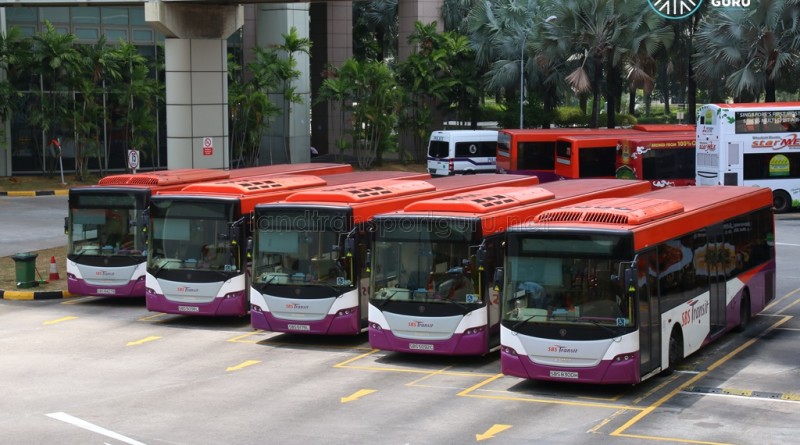


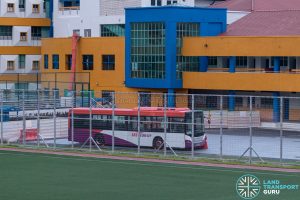
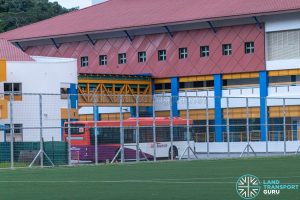
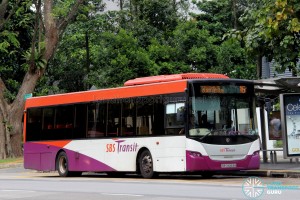
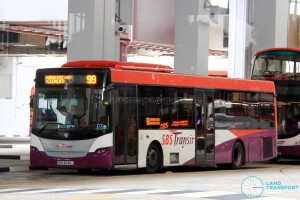
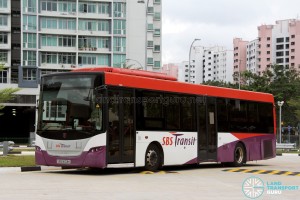
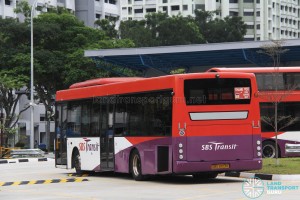
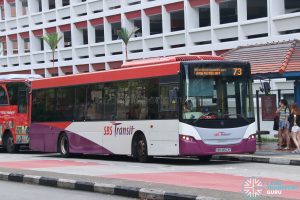
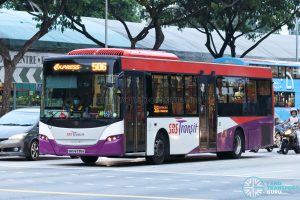
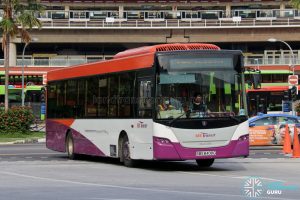
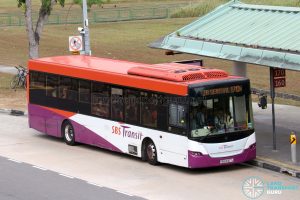
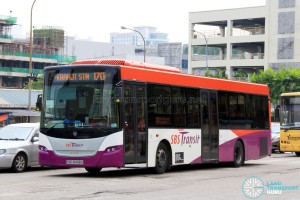


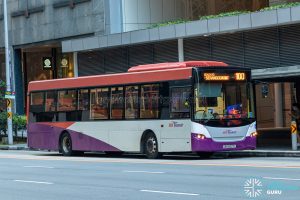
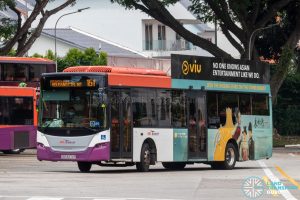
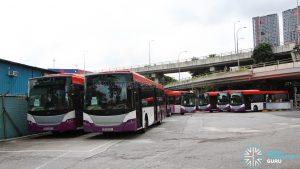
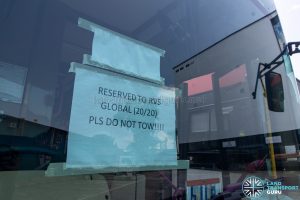
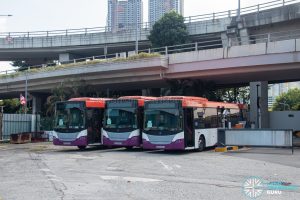
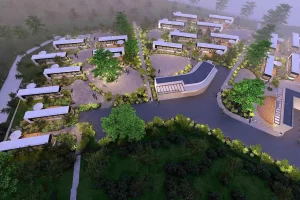
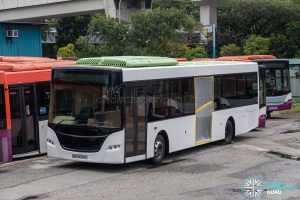
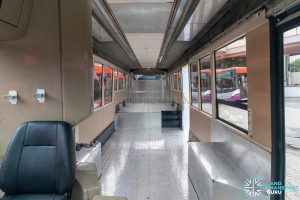
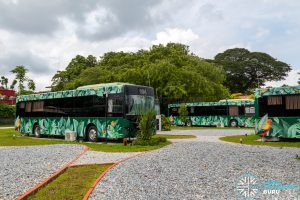
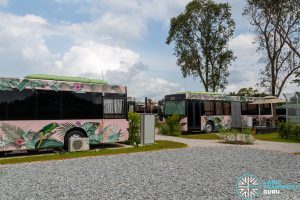

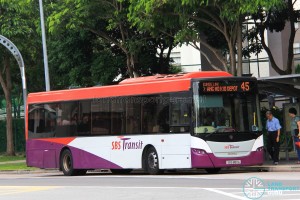
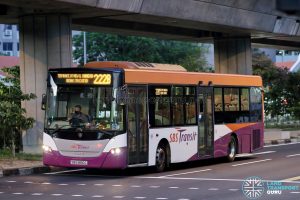
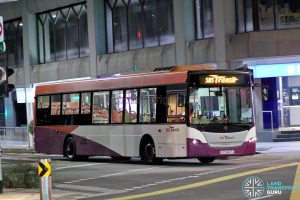
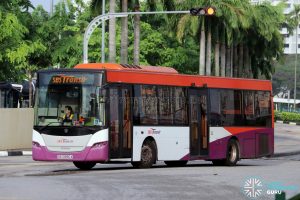

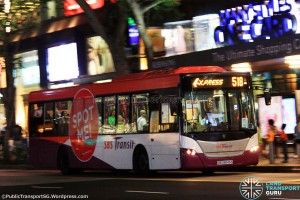


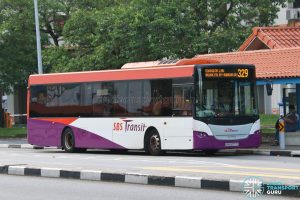


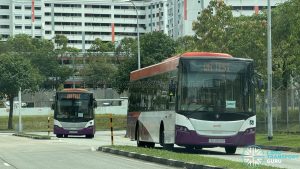
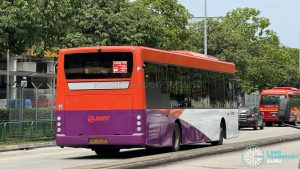
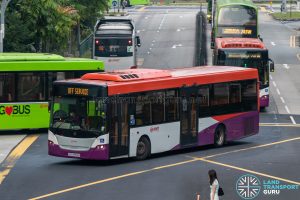

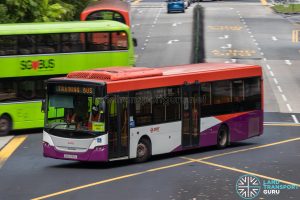
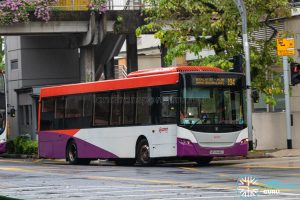

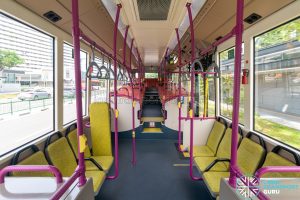
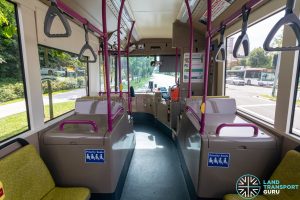
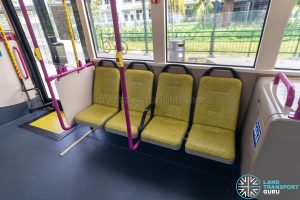

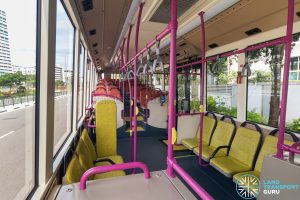
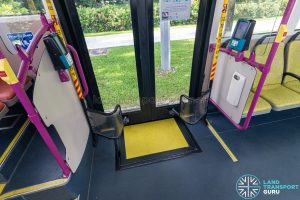
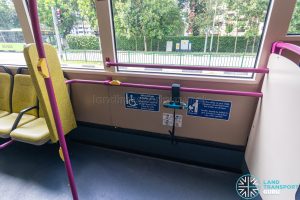
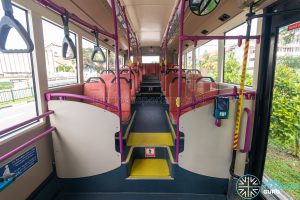
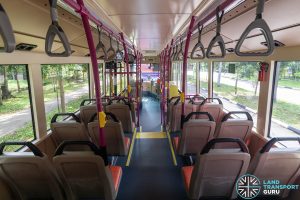
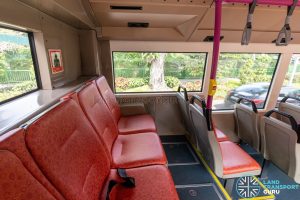

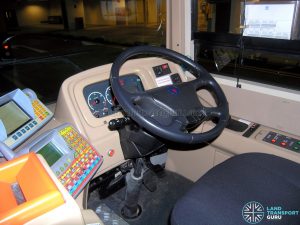
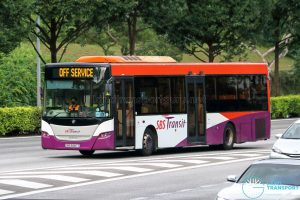
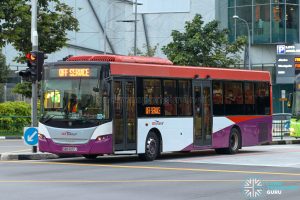

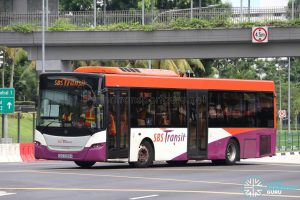
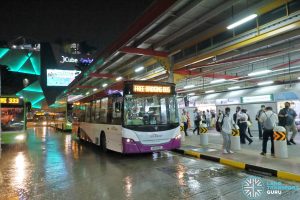
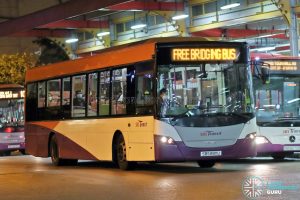
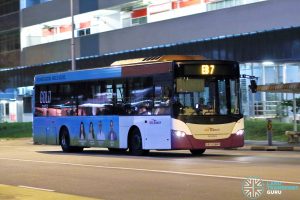
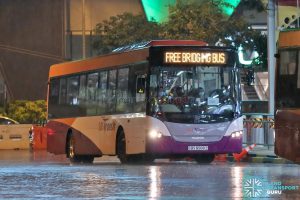

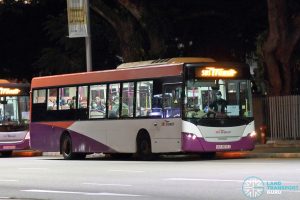

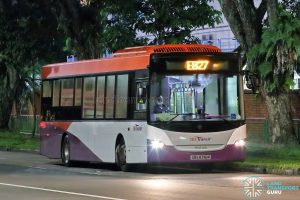

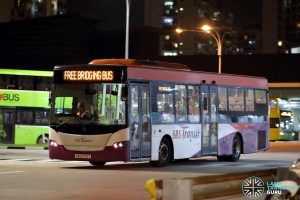

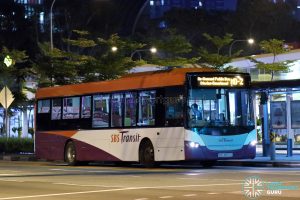
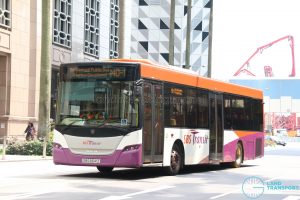
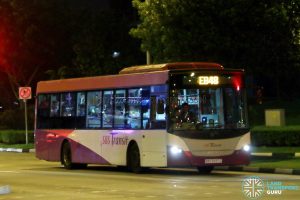
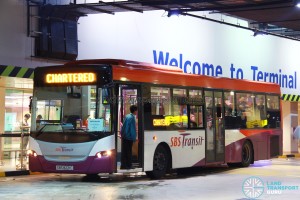
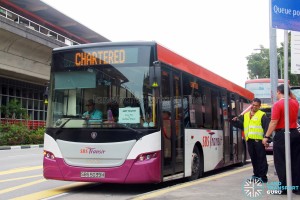
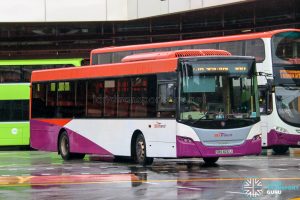
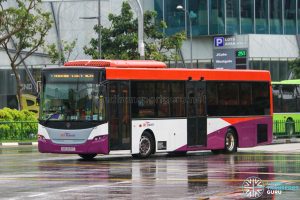

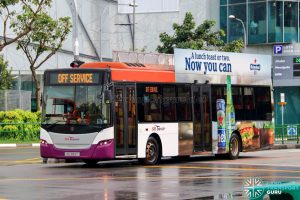
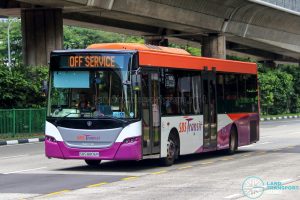
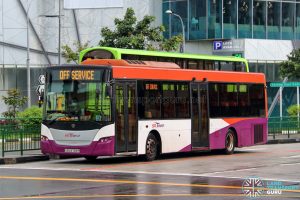
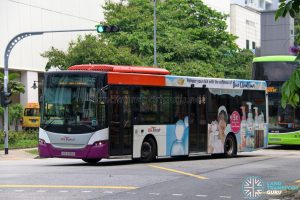
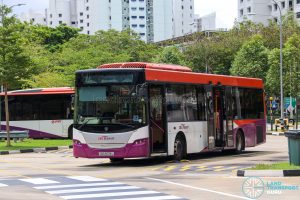
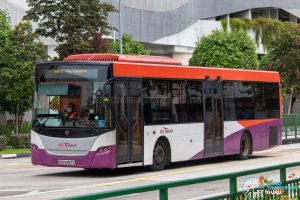

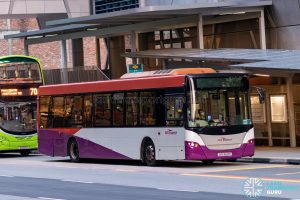
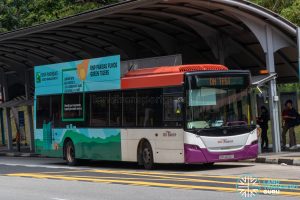
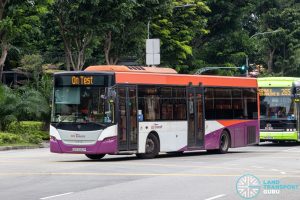

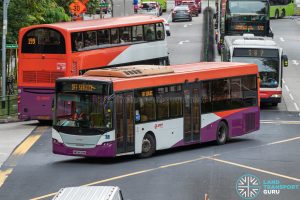
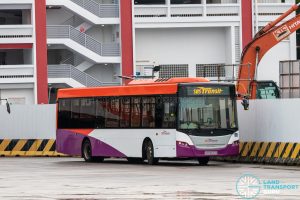
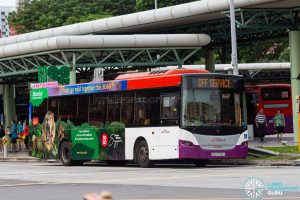
All Euro IV Scania K230UB buses which never underwent mid-life refurbishment have been retired from revenue service, thus all Euro IV Scania K230UB buses in revenue service from this week onwards all underwent mid-life refurbishment.
SBS5050Z was involved in an accident of 2 K230UBs in 2016 iirc
The First Scania K230UB Euro IV that was laid up since 1 JAN 2022 has officially been scrapped as of today. The rest that were laid up on 1 jan 2022 is likely to be scrapped progressively by end 2022. Its possible those refurbished Euro IV Kubs might be retired by early 2023. SBS8039M is the first to be scrapped btw(perm 156), this marks the First Euro IV Bus/KUB to be scrapped and The Second KUB to be scrapped after SBS8900B
Refurbishment of the Euro 5 K230UBs has begun with SBS8955T, SBS8666C and SBS5219E being refurbished.
Scrapping of the current laid up Scania KUB E4s could commence anytime soon as over 120+ Volvo B9TL CDGES has been scrapped. The remaining CDGES on the road might be redrawn soon as well so catch them if you still can, its unclear whether they will stay till the end by 2023. Common Services for CDGES: 25. Other routes that still use CDGES: 14, 46, 196. Also according to rumors, serveal Scania K230UB Euro 5 has commence Refurbishment…